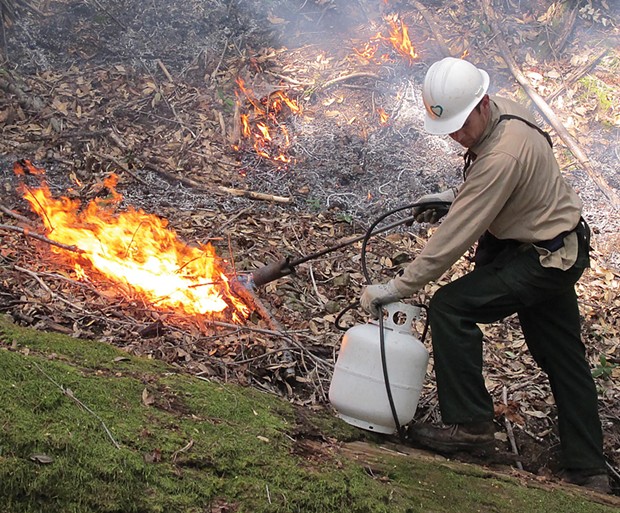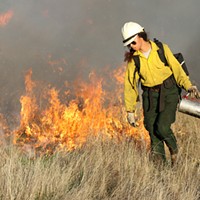[
{
"name": "Top Stories Video Pair",
"insertPoint": "7",
"component": "17087298",
"parentWrapperClass": "fdn-ads-inline-content-block",
"requiredCountToDisplay": "1"
}
]
I lay in bed at 3 a.m. unable to sleep, mind on fire with a thousand loose ends from planning another crazy prescribed fire training exchange (TREX) event. My youngest, Rory, nestled beside me looking angelic in the dappled Alameda streetlight.
I am not at our Klamath TREX for the first time since its inception in 2014. Now that we had the silly idea of standing up a burn team for two months, I have to be in the Bay with my kiddos for some weeks. No ... I get to be in the Bay with Owen and Rory, making magic in this time before they fly.
But these are the burn days when fire speaks in the old tongue and brings new life, that makes the planning work all year seem worth it, and I feel its pull 300 miles away. I tiptoe into the living room to write until the interior voices quiet.
I meant to write my Mid Klamath Watershed Council newsletter article, but, damned, if I didn't get sucked in to looking at the recent pics from the TREX burn Tuesday in Happy Camp at Morgan Point. One picture said a thousand words: the firing team watching the fire they are putting down. Even from here I can hear the radio chatter, firing boss and holding boss and burn boss and operations, fire effects monitors, all talking, sharing observations, dialing the tempo of the burn to maximize the benefits. Fire men and women from this place, and some amazing teachers from around the north state and around the world, and the next generation of fire practitioners, all working together with a common goal.
Old fire dogs from municipal departments. Agency firefighters picking up some extra training assignments after a long fire season, planning forward to when their legs don't buck the mountains like they do now. Scientists whose plots are set to show how fire changes the vegetation and fuels. Students here to do something real, to learn practical skills, to help tell a part of this unfolding story.
And the Karuk Tribe's K1 fire crew, who have, since the beginning, been integrating into these burn teams, sharing not just local fire knowledge, but also the fix-the-world view, as they fix themselves, connecting with their culture through the practice of applying fire to the land.
The fire candles up the largest pine in a stringer of honeysuckle, blackberry and poison oak, speaking of a time when this was meadow, making the lighters go slow to keep the older trees from torching. All these clues that speak of the forest before suppression. Let's go there — 180-200 years ago into an early October.
First, disappear every tree you see in this picture. Notice the old stump holes from the initial logging for flume to service the Muck-A-Muck Mine. Massive sugar pine, ponderosa pine, cedar, huge true oaks dotting the meadow. It's way more open and you can see much farther, up to the low snaky serpentine ridge jutting far out into the Klamath canyon and almost down to the river. You can see the ground and the sky. Instead of pine duff and ferns and brambles and poison oak, there's a lush pasture of native grass, fed by deep springs. Brodiaea, hazel, mock orange, native raspberries. A huge old bay tree that gets visited often. It feels like a garden, like a giant garden. Without a fence.
The village is nearby, pit houses nestled in the high bar river silt. The sound of a drum and singing, gambling. Still alive with the spirit of the New Year ceremonies. Salmon drying on sticks on the river bar. Kids remembering that story about Chemooch, the lizard, when he tricked Grizzly Bear, and keeping an eye out and not straying too far. Fires lit weeks ago still skunking around in the tan oaks between the meadow and the ridge, all the grass from the spring already burned off, revealing the fresh growth rising from the first fall rains. Time in the day to think about and take care of the generations to come. To keep the world whole.
Time speeds up. Two hundred years later and I hear Tyler Conrad singing in the old tongue, his song projected with love and sorrow and hope and joy and strength. Without words, I feel all that was broken, the unholy path from there to here. I remember the old name for Happy Camp from Jack Norton's truth-telling book, Genocide in Northwestern CA. My vision is clouded by privilege, by thick trees and brush, by tears for those who see the echoes of the genocide in their family tree, for those we have lost along the way.
In the end, our success in restoring fire practices, and the forests that were shaped by these fires, hinges on our ability to create a shared vision of what we are managing toward. Reconciling what was and what is, and working toward what could be; it's a hard balance. This is private land. We won't kill very many pines in this burn as we honor the landowner's wishes but still nudge this stand toward the long-term cultural and ecological goals we agreed to through the Western Klamath Restoration Partnership. This fire will open up a little light for some grass to come in, protect the larger conifers, but also make room for some oaks to return. Bring back the game. Open up the view. Clear my vision.
I owe it to this land that feeds me, to our tribal community and to all us settlers to learn to see the forest through these trees, to set in motion things we will not see in our lifetimes but will benefit future generations, to remember my responsibility to all living things in my actions. This is the time to make space for fire to come back in a good way. Support Native communities as they reclaim their right to use fire as a tool for managing the land.
I am getting older and my legs won't always be able to drag the torch. Still hoping for another 30 years or so, and next week we will be burning in Orleans ... I promise I will quit when my knuckles hit the dirt. But I am more certain now than ever before that there will be others to carry this torch. And that is some good medicine. Rory's alarm is about to go off. I should get a little sleep before the sun. Might even take a nap this afternoon. Make sure to remember to bring Rory with me burning this winter so she has a relationship with fire from a young age. My teachers are passing. It is time for me to pick up their torch, and at the same time be passing it on.
Editor's note: This was first posted to Will Harling's Facebook page and is re-published here with permission.
Will Harling is a director of the Mid Klamath Watershed Council. He lives with his family in Forks of Salmon, where he was born and raised.
Latest in News
Readers also liked…
-
Through Mark Larson's Lens
A local photographer's favorite images of 2022 in Humboldt
- Jan 5, 2023
-
'To Celebrate Our Sovereignty'
Yurok Tribe to host gathering honoring 'ultimate river warrior' on the anniversary of the U.S. Supreme Court ruling that changed everything
- Jun 8, 2023

































